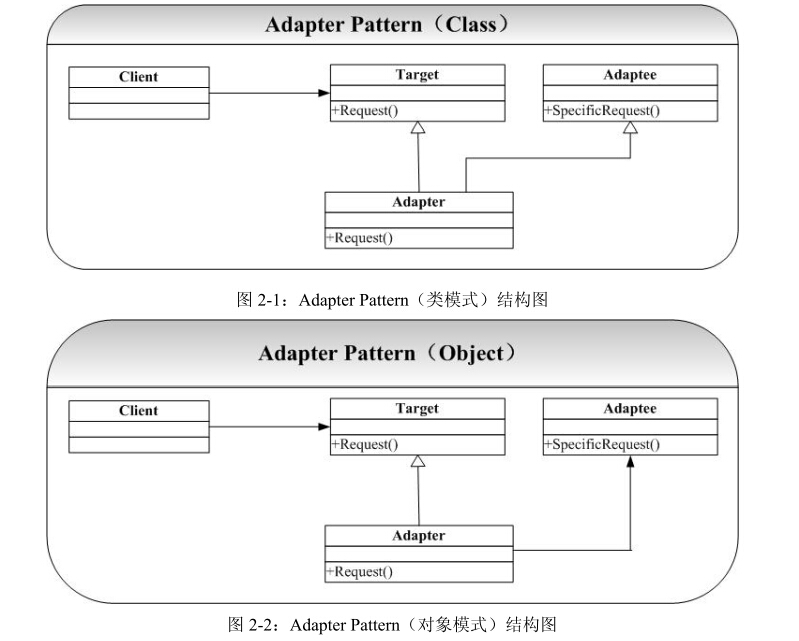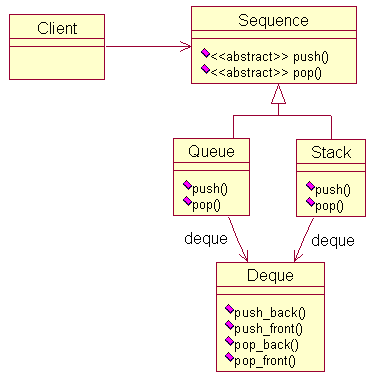[设计模式] 7 适配器模式 adapter

在 Adapter 模式的结构图中可以看到,类模式的 Adapter 采用继承的方式复用 Adaptee
的接口,而在对象模式的 Adapter 中我们则采用组合的方式实现 Adaptee 的复用
类模式的adapter
#include<iostream> using namespace std; class Target
{
public:
Target();
virtual ~Target();
virtual void Request();
protected:
private:
};
class Adaptee
{
public:
Adaptee();
~Adaptee();
void SpecificRequest();
protected:
private:
};
class Adapter:public Target,private Adaptee
{
public:
Adapter();
~Adapter();
void Request();
protected:
private:
}; Target::Target()
{
}
Target::~Target()
{
}
void Target::Request()
{
std::cout<<"Target::Request"<<std::endl;
}
Adaptee::Adaptee()
{ } Adaptee::~Adaptee()
{
}
void Adaptee::SpecificRequest()
{
std::cout<<"Adaptee::SpecificRequest"<<
std::endl;
}
Adapter::Adapter()
{
}
Adapter::~Adapter()
{
}
void Adapter::Request()
{
this->SpecificRequest();
} int main(int argc,char* argv[])
{
Target * adt = new Adapter(); adt->Request(); return ;
}
对象模式的 Adapter
#include<iostream> using namespace std; class Target
{
public:
Target();
virtual ~Target();
virtual void Request();
protected:
private:
};
class Adaptee
{
public:
Adaptee();
~Adaptee();
void SpecificRequest();
protected:
private:
};
class Adapter:public Target
{
public:
Adapter(Adaptee* ade);
~Adapter();
void Request();
protected:
private:
Adaptee* _ade;
};
Target::Target()
{
}
Target::~Target()
{
}
void Target::Request()
{
std::cout<<"Target::Request"<<std::endl;
}
Adaptee::Adaptee()
{
}
Adaptee::~Adaptee()
{
}
void Adaptee::SpecificRequest()
{
std::cout<<"Adaptee::SpecificRequest"<<
std::endl;
}
Adapter::Adapter(Adaptee* ade)
{
this->_ade = ade;
}
Adapter::~Adapter()
{
}
void Adapter::Request()
{
_ade->SpecificRequest();
} int main(int argc,char* argv[])
{
Adaptee* ade = new Adaptee; Target* adt = new Adapter(ade); adt->Request(); return ;
}
说明
Adapter 模式实现上比较简单,要说明的是在类模式 Adapter 中,我们通过 private 继承Adaptee 获得实现继承的效果,而通过 public 继承 Target 获得接口继承的效果(有关实现继承和接口继承参见讨论部分)。
讨论
在 Adapter 模式的两种模式中,有一个很重要的概念就是接口继承和实现继承的区别和联系。接口继承和实现继承是面向对象领域的两个重要的概念,接口继承指的是通过继承,子类获得了父类的接口,而实现继承指的是通过继承子类获得了父类的实现(并不统共接口)。在 C++中的 public 继承既是接口继承又是实现继承,因为子类在继承了父类后既可以对外提供父类中的接口操作,又可以获得父类的接口实现。当然我们可以通过一定的方式和技术模拟单独的接口继承和实现继承,例如我们可以通过 private 继承获得实现继承的效果(private 继承后,父类中的接口都变为 private,当然只能是实现继承了。),通过纯抽象基类模拟接口继承的效果,但是在 C++中 pure virtual function 也可以提供默认实现,因此这是不纯正的接口继承,但是在 Java 中我们可以 interface 来获得真正的接口继承了。
一个对象模Adpater的例子:
DP上的定义:适配器模式将一个类的接口转换成客户希望的另外一个接口,使得原本由于接口不兼容而不能一起工作的那些类可以一起工作。它包括类适配器和对象适配器,本文针对的是对象适配器。举个例子,在STL中就用到了适配器模式。STL实现了一种数据结构,称为双端队列(deque),支持前后两段的插入与删除。STL实现栈和队列时,没有从头开始定义它们,而是直接使用双端队列实现的。这里双端队列就扮演了适配器的角色。队列用到了它的后端插入,前端删除。而栈用到了它的后端插入,后端删除。假设栈和队列都是一种顺序容器,有两种操作:压入和弹出。下面给出相应的UML图,与DP上的图差不多。

根据上面的UML图,很容易给出实现。
//双端队列
class Deque
{
public:
void push_back(int x) { cout<<"Deque push_back"<<endl; }
void push_front(int x) { cout<<"Deque push_front"<<endl; }
void pop_back() { cout<<"Deque pop_back"<<endl; }
void pop_front() { cout<<"Deque pop_front"<<endl; }
};
//顺序容器
class Sequence
{
public:
virtual void push(int x) = ;
virtual void pop() = ;
};
//栈
class Stack: public Sequence
{
public:
void push(int x) { deque.push_back(x); }
void pop() { deque.pop_back(); }
private:
Deque deque; //双端队列
};
//队列
class Queue: public Sequence
{
public:
void push(int x) { deque.push_back(x); }
void pop() { deque.pop_front(); }
private:
Deque deque; //双端队列
};
int main()
{
Sequence *s1 = new Stack();
Sequence *s2 = new Queue();
s1->push(); s1->pop();
s2->push(); s2->pop();
delete s1; delete s2;
return ;
}
[设计模式] 7 适配器模式 adapter的更多相关文章
- 乐在其中设计模式(C#) - 适配器模式(Adapter Pattern)
原文:乐在其中设计模式(C#) - 适配器模式(Adapter Pattern) [索引页][源码下载] 乐在其中设计模式(C#) - 适配器模式(Adapter Pattern) 作者:webabc ...
- 8.3 GOF设计模式二: 适配器模式 Adapter
GOF设计模式二: 适配器模式 Adapter 为中国市场生产的电器,到了美国,需要有一个转接器才能使用墙上的插座,这个转接 器的功能.原理?复习单实例模式 SingleTon的三个关键点 ...
- 怎样让孩子爱上设计模式 —— 7.适配器模式(Adapter Pattern)
怎样让孩子爱上设计模式 -- 7.适配器模式(Adapter Pattern) 标签: 设计模式初涉 概念相关 定义: 适配器模式把一个类的接口变换成client所期待的还有一种接口,从而 使原本因接 ...
- 二十四种设计模式:适配器模式(Adapter Pattern)
适配器模式(Adapter Pattern) 介绍将一个类的接口转换成客户希望的另外一个接口.Adapter模式使得原本由于接口不兼容而不能一起工作的那些类可以一起工作.示例有一个Message实体类 ...
- 【设计模式】适配器模式 Adapter Pattern
适配器模式在软件开发界使用及其广泛,在工业界,现实中也是屡见不鲜.比如手机充电器,笔记本充电器,广播接收器,电视接收器等等.都是适配器. 适配器主要作用是让本来不兼容的两个事物兼容和谐的一起工作.比如 ...
- Java设计模式之适配器模式(Adapter)
转载:<JAVA与模式>之适配器模式 这个总结的挺好的,为了加深印象,我自己再尝试总结一下 1.定义: 适配器模式把一个类的接口变换成客户端所期待的另一种接口,从而使原本因接口不匹配而无法 ...
- JavaScript设计模式 Item9 --适配器模式Adapter
适配器模式(转换器面模式),通常是为要使用的接口,不符本应用或本系统使用,而需引入的中间适配层类或对象的情况. 适配器模式的作用是解决两个软件实体间的接口不兼容的问题. 一.定义 适配器模式(Adap ...
- python 设计模式之适配器模式 Adapter Class/Object Pattern
#写在前面 看完了<妙味>和<华医>,又情不自禁的找小说看,点开了推荐里面随机弹出的<暗恋.橘生淮南>,翻了下里面的评论,有个读者从里面摘了一段自己很喜欢的话出来, ...
- java设计模式之六适配器模式(Adapter)
适配器模式将某个类的接口转换成客户端期望的另一个接口表示,目的是消除由于接口不匹配所造成的类的兼容性问题.主要分为三类:类的适配器模式.对象的适配器模式.接口的适配器模式.首先,我们来看看类的适配器模 ...
随机推荐
- 依赖映射 Dependent Mapping
让一个类为其子类(泛意上的)执行DB映射 一些对象肯定会出现在另一对象的上下文中. 此时,使用另一对象的Mapper来执行第一个对象的映射,来简化映射过程. 运行机制 在DB持久化时,依赖者类依赖于所 ...
- linux 信号列表和基本作用
我们运行如下命令,可看到Linux支持的信号列表: $ kill -l 1) SIGHUP 2) SIGINT 3) SIGQUIT 4) SIGILL 5) SIGTRAP 6) SIGABRT 7 ...
- 【风马一族_Java】java的一种IDE
IntelliJ IDEA 14 下载地址: IntelliJ IDEA 14 下载 分享几个license: (1) key:IDEA value:61156-YRN2M-5MNCN-NZ8D2-7 ...
- 9种jQuery和css3图片动画特效代码演示
1.自由旋转的jQuery图片 演示和下载地址 2.css3阴影动画效果 演示和下载地址 3.拉窗帘特效图片 演示和下载地址 4.css3文字特效动画 演示和下载地址 5.css3时钟代码 演示和下载 ...
- js设计模式(7)---装饰者模式
0.前言 下午做事效率很低,无精打采的,整个脑子就跟浆糊一样,看看时间一点点流去,心中只能无可奈何,哎,码农的激情难道就这么容易熄灭吗? 1.该模式的使用情况 假如我们想给对象增加功能,但是又不想修改 ...
- Mongodb地理空间索引
1.索引: 建立索引既耗时也费力,还需要消耗很多资源.使用{"bakckground":true}选项可以使这个过程在后台完成,同时正常处理请求.如果不包括background 这 ...
- 使用android.support.design.widget.TabLayout出现java.lang.reflect.InvocationTargetException
解决方法: 1.在res里面的Values里面的styles定制一个自己的colorPrimary <style name="MyAppTheme" parent=" ...
- 精美舒适的对话消息提示框--第三方开源--SweetAlertDialog
SweetAlertDialog(sweet-alert-dialog)是一个套制作精美.动画效果出色生动的Android对话.消息提示框 SweetAlertDialog(sweet-alert-d ...
- html css布局
这几天有点急于求成了,原来每一门技术都像大海,只有深入其中才发现它比看到的更要深广的多. 虽然忙里偷闲的看了HTML5,NODE.JS,JAVASCRIPT核心等许多东西,但是真正掌握的不足十分之一, ...
- Mac OS X 安装 brew 工具!
最早的ports管理就是BSD那种,后来出现强大的Debian,弄了个dpkg+apt! Mac OS X 最早使用比较多的工具是 MacPorts,但是现在来看这个工具有点老,不是很稳定,那我们推荐 ...
